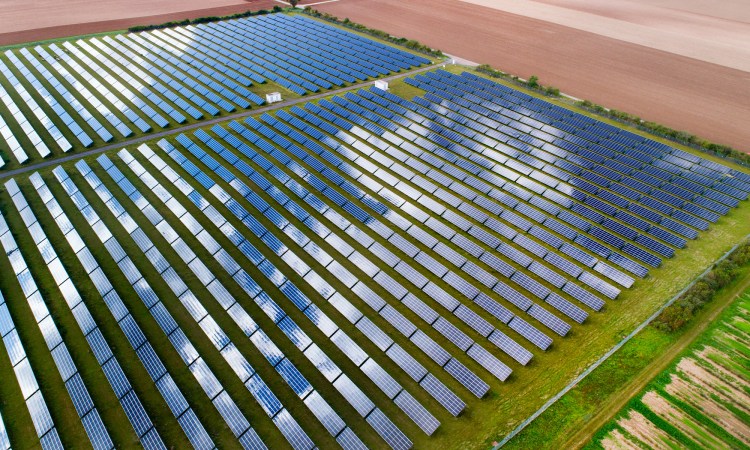
Someday, solar panels may be light and cheap enough that they could be hung on a clothesline, thanks to a synthetic mineral called perovskite. Physicist Sam Stranks explains the solar-powered science and the challenges that stand in its way.
Solar power is key to our energy future. But the solar industry is butting up against one hard problem: Silicon cells are not very efficient at converting sunlight into electricity — at best, about 29 percent efficient. You may wonder, Why does efficiency even matter, when sunlight is free? The answer: because low efficiency means you need to install a whole lot of solar panels — which can be large, heavy and expensive to manufacture — to generate enough energy to make a dent in your needs.
But that could change thanks to a mineral called perovskite, according to Cambridge University physicist (and TED Fellow) Sam Stranks. He and his colleagues at Swift Solar are working to develop perovskite-based solar panels that could break the energy-efficiency upper limit.
What in the world is perovskite? The term “perovskite” refers to two substances: a calcium titanium oxide mineral composed of calcium titanate, and also the class of compounds that share the mineral’s unique crystal structure. The perovskites that hold such promising photovoltaic (PV), or solar energy-generating, properties are a group of human-made versions discovered in 2009 by Japanese scientist Tsutomu Miyasaka and colleagues. (Miyasaka was talked about in 2018 as a potential Nobel Prize recipient.) “These perovskites can absorb sunlight better than silicon,” says Stranks. “We can absorb almost all of the sunlight with a perovskite film that is at least a hundred times thinner than silicon.”
Scientists synthesize perovskites by mixing two inexpensive salts, lead halides and organic halides. This solution forms an ink, which can be applied in an ultrafine, uniform layer by using inkjet printing or spin coating. “The film deposited is very thin — around 500 nanometers or about 1/100th the thickness of a human hair — and it is enough to absorb a large fraction of the sunlight needed to generate electricity,” says Stranks.
The upshot: A little perovskite can generate a lot of power. “The state of California requires 50 gigawatts of power, for example,” says Stranks, “and to make enough solar panels, you’d only need half an Olympic swimming pool’s worth of perovskite ink.”
Another plus: A perovskite cell factory could be a lot less expensive than a silicon factory. While a silicon factory costs roughly $300 million to $400 million to build, a perovskite factory could cost less than $100 million. “The difference in expense is partly because making highly crystalline silicon requires heating it to a very high temperature to get rid of defects,” says Stranks. “Perovskite films, on the other hand, only need gentle heating to be defect-free, and they can be rolled out rapidly on big printers, which is more cost-effective.”
While perovskite probably won’t replace silicon cells right away (to learn why, read on), the two compounds can work together. “It’s not an either/or proposition with silicon, but both/and,” says Stranks. Perovskite cells can be layered over existing silicon solar cells — in a “tandem” cell — to raise their efficiency. Boosting silicon with perovskite could make each PV panel 20 percent more efficient than today’s PV panels, contends Stranks. The increase in efficiency has effects that could ripple out through the solar-energy process. He explains, “If you’re installing a house that would’ve previously needed five panels, you now only need four. That changes things a lot: the panels for a solar farm would suddenly be 20 percent less expensive, as well as other cost savings, and so on.”
Here’s how a tandem cell works. The job of a solar cell is to harvest the various wavelengths of light — which are perceived as different colors — in the visible spectrum and convert them into energy. “When you layer a perovskite cell on top of a silicon cell, the perovskite layer harvests the bluer light, which is the highest-energy visible light, and converts it into electrical power,” says Stranks. “The rest of the light then travels through to the silicon cell below, which absorbs the redder, lower-energy rays and converts those into power. The idea is that, with both layers, you’re harvesting almost the entire spectrum of light, but you’re doing it sequentially to maximize the amount of power produced.”
Why not get rid of silicon altogether and just use perovskite? That’s the goal, says Stranks. Perovskite-perovskite tandem cells — a concept first demonstrated by his cofounders Giles Eperon and Tomas Leijtens — are a technology being developed by the team at Swift Solar. Two different types of perovskite cells are placed on top of each other, and just as tandem perovskite-silicon cells harvest different frequencies of light, so do tandem perovskite-perovskite cells. These could potentially push the efficiency up to 35 percent or higher.
Why silicon still matters: We don’t know how long a perovskite cell lasts. “Silicon cells last 25 years, while perovskite cells have yet to be sufficiently proven under such environmental stressors as moisture and heat,” says Stranks. (Remember, the material was only discovered in 2009.) And if you’re installing an expensive solar array on your house, you want it to last for a few decades at least. Stranks is optimistic that perovskite cells can be made durable, perhaps by optimizing the compositions and the cell designs. Meanwhile, tandem perovskite cells can start to be used in transport and communication applications that don’t require long-term durability.
Perovskites could bring power to new customers in new forms. Stranks envisions perovskite cells providing power someday in rural areas in developing countries. While silicon panels are already being installed and used in all kinds of settings, they can be heavy and bulky. “An idea would be to roll off these cheap solar sheets, fill a truck with them to be used in remote communities. The sheets could be hung on a clothesline, installed on the roof of a shelter, and so on,” he says. “A typical sheet, deployed with a storage battery, could power a mobile phone charger, lamps or a small refrigerator.” According to Stranks’s best guess, it may take up to a decade before perovskites reaches consumers’ lives. “We’ve still got work to do, and it will take a global push to realize the full potential of perovskites,” he says. “But given the price of cheap, clean energy, the future is bright.”
Watch his TED talk here:












